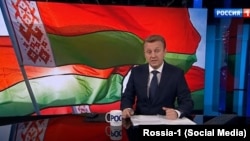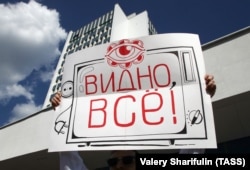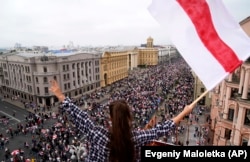As Belarus and Russia move to strengthen their ties in response to ongoing Belarusian protests against election fraud, the two countries’ state-controlled TV channels have begun to mirror each other’s content to warn against the risk of a supposed Maidan-style revolution in Belarus and convince viewers that NATO member Poland plans a Belarusian-territory grab.
The synced coverage began after Belarus’ August 9 presidential election, when protesters took to the streets throughout the country to denounce election fraud, police violence, and to call for a fresh vote.
But it intensified after President Alyaksandr Lukashenka announced on August 27 that he had invited employees from the Kremlin-financed television network RT to help out at state broadcasters. In outrage at the police treatment of protesters and at their own channels’ coverage of the demonstrations, employees at these stations began to resign or go on strike in late August.
One anonymous employee of state TV channel Belarus-1 told the Russian news outlet RBC that the station had been effectively “paralyzed” for lack of technical staff.
The Belarusian government sees the media message about the protests as a matter of national security: It has detained, deported, or scrapped the accreditation of multiple journalists reporting on the protests for foreign media organizations, including Current Time and its parent organization, Radio Free Europe/Radio Liberty.
To ensure Belarus’ TV channels, all state-run, stayed on the air and on message about the protests, Lukashenka looked to teams of employees from Russia’s Kremlin-run RT, often described as a propaganda network.
But the cooperation did not stop at technical or editorial support alone.
The ‘Maidan’ Menace
For years, Russian state TV channels have scared Russians with the word “Maidan,” used as a synonym for political instability and street-born revolutions.
On August 27, Mykola Azarov, a former Ukrainian prime minister now living in Russia, echoed that message, telling Belarus’ state-run ONT that the ongoing protests remind him of “the preparation” for Ukraine’s “first Maidan;” the 2004-2005 demonstrations against fraudulent presidential election results that eventually led to a change of government.
The 72-year-old Azarov’s own Maidan experience dates to 2014, when protests over Kyiv’s decision to scuttle a cooperation agreement with the European Union led to Azarov’s resignation and his departure, along with his patron, ousted President Viktor Yanukovych, for Russia.
Drawing on that background, Azarov underlined to Belarusians that
“It’s completely clear that the Western special services began preparing long ago for Belarus’ elections.”
Eventually, he speculated, that will lead to bans on the use of Russian within Belarus as a way to sever the country’s ties with Russia.
Concrete proof of such “preparations” may not exist, but the claims alone are familiar now to both Belarusian and Russian TV audiences.
The ‘Hand Of The West’
Belarusian authorities routinely appear on TV to speak about “the hand of the West” – a turn of phrase that signifies that Western intelligence agencies are running the demonstrations as a covert operation. Russia, too, has long held that large-scale protests in Ukraine, Georgia, and Kyrgyzstan that led to the departure of relatively Moscow-friendly leaders rank among such operations.
In Belarus’ case, Belarusian and Russian broadcasters assert that the protests are intended to secure the “partition of Belarus” – a reference to the country’s western region of Hrodna, which was part of Poland from 1921 until 1939.
On August 27, ONT took aim at a tweet by Polish journalist Tomasz Sommer, editor of the conservative Najwyższy Czas! magazine, that termed it “completely obvious” that Hrodna should return to Poland if Belarus collapses.
“And we’re still trying to be correct and are embarrassed to say that they’re rudely interfering in Belarus’ domestic affairs,” ONT Chairman of the Board Marat Markov commented on air.
Lukashenka as well has warned of a Polish takeover of Hrodna, should Belarus become unstable – an accusation that Polish presidential aide Krzysztof Szczerski has rejected as “unfounded,” “unacceptable,” and “propaganda.”
But his remarks did nothing to dissuade Russia’s government broadcasters.
Two days after Szczerski’s August 28 interview with Polish public radio, Moscow’s Channel One included Sommer’s words as part of a week-in-review report about Belarus’ protests.
Following ONT’s lead, Rossia-1, another Russian state TV channel, declared that “Polish radicals already are openly dividing up Belorussia, declaring that Hrodna should go to Poland.”
On August 31, the channel mentioned U.S. military training exercises near the Belarusian border in Poland, a NATO member, as part of another report about these alleged plans.
NATO Secretary General Jens Stoltenberg already had rejected the notion of the Alliance’s armed intervention in Belarus – a theory touted by Lukashenka as well.
But, already, like a link chain, the Belarusian-Russian media claim of Polish designs on Belarusian territory has become joined to another supposed threat.
The Russian Language ‘Under Threat’
Aside from speculation about Poland, Belarusian and Russian channels are now focusing on what they describe as Belarusian opposition plans to ban the use of Russian and close all Russian-language schools.
Such claims also have marked Russian media coverage of Ukraine, particularly related to the disputed eastern Donbas region, which has a large ethnic Russian population.
Belarus’ official languages include both Belarusian and Russian. Surveys suggest that Russian ranks as the primary language of the vast majority of the country’s population of some 9.5 million.
But those details did not give pause to Rossia-1.
In an August 28 interview on YouTube, former Belarusian President Stanislau Shushkevich (1991-1994) had called for an end to Russian’s status as Belarus’ second official language, blaming the government for stamping out Belarusian culture.
Shushkevich, who signed the December 1991 accords with Russia and Ukraine that dissolved the Soviet Union, lambasted Lukashenka’s iron-fisted rule and described the protests as an attempt to restore justice.
That apparently helped bring Shushkevich to Rossia-1’s attention.
“Under Shushkevich in the 90s, they imposed the Belarusian language on people,” the station incorrectly informed viewers on August 30. “And closed Russian-language schools by force so that there are almost none left.”
“What’s happening in our country is a usual Eastern European color revolution,” Belarusian political analyst Yury Shevtsov commented to Rossia-1. “This means that, at some point, the question of distancing from Russia through language will come up.”
The next day, August 31, Belarus’ ONT had a report that reinforced that message, drawing on Ukraine’s 2014 EuroMaidan protests.
Referring to a May 2, 2014 building fire that killed 48 people during clashes in Odesa, one Vadim Borisyuk, introduced as a Belarusian “volunteer,” asserted that “nationalists” had “simply burned people because they wanted to speak Russian, because they wanted stability.”
Such accusations are a mainstay of state-run Russian media reports against the EuroMaidan uprising. EuroMaidan supporters, however, blame allegedly “pro-Russia” protesters for the deaths.
That view, however, was not shared by ONT.
A Flag That Signals Fascism?
Like ONT, state-controlled Russian media routinely depicts supporters of Ukraine’s Maidan protests as “nationalists” or “fascists.” Borisyuk, the man interviewed by ONT, provided a way to extend that description to Belarusian protesters.
The police who picked up his Belarusian grandfather during Nazi Germany’s 1941-1944 occupation of Belarus, he recounted to the Belarusian state broadcaster, wore white-red-white armbands like the flags that Belarusian protesters carry today.
“I never expected that this would be in the streets of Belarus, that they would carry the flags, not understanding what flags they are; flags that, personally for me, are just associated with the accomplices of the fascists, who were here in Belarus.”
The white-and-red horizontal triband was first adopted by the independent Belarusian Democratic Republic formed in 1918, after the collapse of the Russian Empire. The republic had ended by 1919, after German occupying forces withdrew and the Bolsheviks came to power.
But Russia’s Channel One had its own backgrounder.
In its telling, “the republic sank into oblivion” after Belarus’ “return" and the Soviet Union's formation. The white-and-red flag, it emphasized, was used by Belarusian “collaborators” with Nazi forces during World War II.
Supporters of Belarus’ protests know that history, but point to the flag’s more recent and widespread use – as Belarus’ national flag after the country regained independence in 1991.
A referendum on President Lukashenka's proposal of a return to the red-and-green Soviet-era flag led to its demise four years later.
A Friend In Need
Though before the presidential elections, President Lukashenka had warned that Moscow intended to spark unrest in Belarus, he now expresses only gratitude for the new collaboration between Belarusian and Russian state channels.
“You understand how important you were to us during this difficult period," he commented to an RT reporter on September 1, two days after a demonstration of tens of thousands in Minsk. "I am grateful for this support," he said.
How long that gratitude will last, however, is unclear. A "popular" question now among Russian media, wrote Kommersant political commentator Dmitry Drize on September 4, is whether Lukashenka is again "leading its ally by the nose."
But for such doubts, the Belarusian leader had a ready answer -- at least for RT: "I have never turned away from Russia," he told the network.
-With reporting by Reuters and Stars and Stripes













